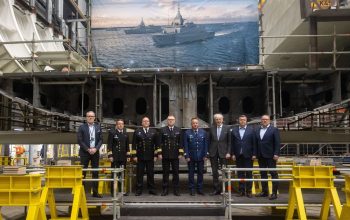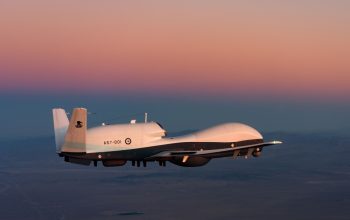The UK’s amphibious flagship today left Plymouth bound for the fjords to play a key role in the largest military exercise in Norway in more than 30 years. HMS Albion heads for the Arctic as the spearhead of amphibious/commando forces taking part in Exercise Cold Response – a month-long test by land, sea and air of allied forces to operate in one of the most challenging environment on the planet. Albion prepared for her Arctic mission with intensive operational training in and around Plymouth which culminated earlier this month in a joint disaster relief/civilian evacuation test, working side-by-side with the Dutch Navy’s HNLMS Karel Doorman.
HMS Albion is embarking a staff to direct amphibious operations, the headquarters of 3 Commando Brigade and Royal Marines packing Albion “absolutely up to the gunnels” from her usual 340 souls to around 1,000 at the height of Cold Response. Alongside landing support ship RFA Mounts Bay, Albion leads the UK’s amphibious input into Cold Response, with “a significant level” of littoral strike operations – traditional-style commando raids – staged in the fjords, with the British force integrating with numerous allies, including the US, Norwegians, French, Germans and Italians.

“The UK has long had a very specific roll up in the high north in the Arctic. And it’s all part of our routine development of that capability. Our ability to plug into and integrate into larger task groups is absolutely the core of all our capabilities, and it’s that integration into the bigger piece of NATO, that collective ability which really brings the fighting edge to NATO. We’re going to Norway at the most challenging time of year. Winter, it will be dark for a long period of the day. And so what we’re trying to do is ensure that we can operate in all environments. As a ship we go up and train in that area very regularly, but for some of the young sailors on board, this will be their first time operating in the Arctic and it’ll be the first time seeing something like the Northern Lights,” said Captain Simon Kelly, HMS Albion’s Commanding Officer.
The climate and geography of northern Norway – temperatures regularly down to -30 Celsius, ice, snow, low cloud, frozen lakes, narrow fjords, mountains and valleys – all add to the complexity of amphibious operations which are generally regarded as the most difficult to perfect. For Cold Response, HMS Albion will be joined by RFA Mounts Bay at the core of the amphibious force, while HMS Prince of Wales takes past as NATO command ship leading a task group including HMS Richmond, HMS Defender, tanker RFA Tidesurge and US Navy destroyer USS Roosevelt. HMS Albion will lead the UK’s amphibious involvement in the Norwegian-led exercise – through March into April. It involves 35,000 troops from 28 nations, with allied warships and aircraft working closely together as the powerful task force tests its ability to protect Norway from modern threats.














